Content
This is particularly crucial given the increasing influence of high frequency trading on the safety of European equity markets and the divergence of dark trading on alternative platforms Smart contract such as systematic internalizers. The first dark pool was established by an institutional investor looking for a more discreet trading venue. Besides, initially, these alternative trading systems operated independently from traditional exchanges. However, as their popularity grew, some exchanges decided to launch their own dark pools to retain market share. The dark pool trading crypto concept offers an environment for large-scale buyers and sellers to execute trades away from public exchanges. The aim is the same – to minimize price impact and maintain privacy, albeit in the context of digital assets.
Can on-chain dark pools revolutionize financial markets?

In 2022, the SEC proposed a rule that would require dark pool operators to execute market orders in public secondary markets rather than privately unless https://www.xcritical.com/ an evident price advantage was offered in dark pools. Assume a financial corporation wants to sell 1,000,000 shares in public exchanges. The company initiates the order with a floor broker for several days to make price estimations and trade valuations and find the best bidding and asking prices.
How to Trade and Profit in the Intriguing Dark Pools

Since 2010, Hong Kong and Singapore have adopted dark pool systems, while Japan and South Korea are integrating these platforms within their respective regulatory frameworks. Maria dark pool trading Chaudhry has extensive experience in financial services including 17 years of trading experience. She has worked for firms Charles Schwab, Scottrade, & TD Ameritrade Institutional.
Dark Pool Trading Indicators: Spotting the Trends
To address this issue, some dark pool operators offer enhanced privacy with contingent orders. These orders allow investors to trade without revealing their intentions until specific conditions are met. In this blog section, we will discuss how contingent orders work and their benefits for investors. They can help to increase privacy, reduce risk, increase control, offer flexibility, and limit slippage.
- This allows traders to execute large orders without affecting the market price.
- The revised directive, MiFID II [3], and a new regulation commonly referred to as MiFIR [4], have had a significant impact on trading practices in European equity markets.
- Moreover, dark trading leads to partial segmentation of informed and uninformed traders.
- These brokers have access to a wide range of financial products, giving clients more options when it comes to investment opportunities.
- However, there have been instances of dark pool operators abusing their position to make unethical or illegal trades.
Challenges Facing Dark Pools in Traditional Financial Markets
The dark pool stock market exchanges define a block trade, which values $200,000 at least, or over 10,000 shares, whereas most dark pool block trades, in reality, involve much more than these figures. Financial markets form a complex system of several underlying exchanges, corporations and market makers that interconnect and depend on each other. A new trader trying to grasp trading elements tends to focus on trading instruments, liquidity levels and market prices.
As such, it’s crucial to gain accurate information and undertake careful study. Adding dark pool trading knowledge to your toolkit could offer a powerful advantage in tracking institutional money for potential profits. In a noteworthy example of the kind of dark pool trading activity that traders should watch out for, the semiconductor sector experienced significant dark activity on February 3rd 2022. This was not business as usual — each and every semiconductor stock in the sector exhibited dark pool data, with most of the activity occurring in the last few hours of the trading day.
The trading system continuously monitors the market for price and volume changes and executes the contingent orders when the conditions are satisfied. This allows investors to trade with enhanced privacy and anonymity, as their orders are not revealed to the wider market until they are executed. Unlike public exchanges, dark pools do not display a publicly available order book. As a result, price discovery in dark pools is often based on the National Best Bid and Offer (NBBO) or derived from other benchmark prices.

Second, on-chain dark pools currently lack a well-defined regulatory framework. Institutional investors must engage cautiously and ensure that all relevant regulatory considerations are reviewed before participating in such markets. One notable example of dark pool trading is the case involving Barclays and Credit Suisse in 2016.
While these significant transactions influence the asset’s final price, they appear to be the natural outcome of market forces. The growth potential of on-chain dark pools is expected to increase significantly. This is evidenced by the rapid rise in private transactions within the Ethereum network.
Otherwise, if corporations trade in bulk in open markets, they can severely affect a company’s stock price, causing a significant price increase or decrease. Another significant advantage of dark pool trading is the potential for reduced transaction costs. In traditional exchanges, the bid-ask spread, which is the difference between the highest price a buyer is willing to pay and the lowest price a seller is willing to accept, can be wide.
The lack of transparency works in the institutional investor’s favor since it may result in a better-realized price than if the sale was executed on an exchange. Dark pools are private exchanges for trading securities that are not accessible to the investing public. Also known as dark pools of liquidity, the name of these exchanges is a reference to their complete lack of transparency. Agency-broker dark pools are another common private trading system that acts as agents instead of a principal.
In response to global reforms like the 2010 Dodd-Frank Act in the USA, revising MiFID was necessary since it failed to meet its objectives, specifically regarding market stability and investor safety. As a result, MiFID II and MiFIR were introduced in 2014, significantly overhauling European securities legislation. These findings are novel in the existing literature on HFT through dark pools.
These pools are not accessible to secondary markets and public traders, which triggers some criticism over the transparency of dark pools. Volume-weighted average price (VWAP) orders are another type of contingent order that are commonly used in dark pools. With a VWAP order, the trader specifies a target price that is based on the average price of the security over a certain period of time, such as the trading day. The order is executed over time, with the algorithm adjusting the order size and timing to ensure that the target price is achieved. Contingent orders are orders that are executed only when certain conditions are met. In dark pool trading, contingent orders are used to execute trades when specific price or volume thresholds are reached.
FIX compliancy, together with the requirements for low latencyand high availability, were cornerstones of the architecture of theplatform. The platform can be used for trading exchanges,alternative trading systems, multilateral trading facilities, darkpools and internalization engines for many asset classes. As of the end of December 2022, there were more than 60 dark pools registered with the Securities and Exchange Commission (SEC).
